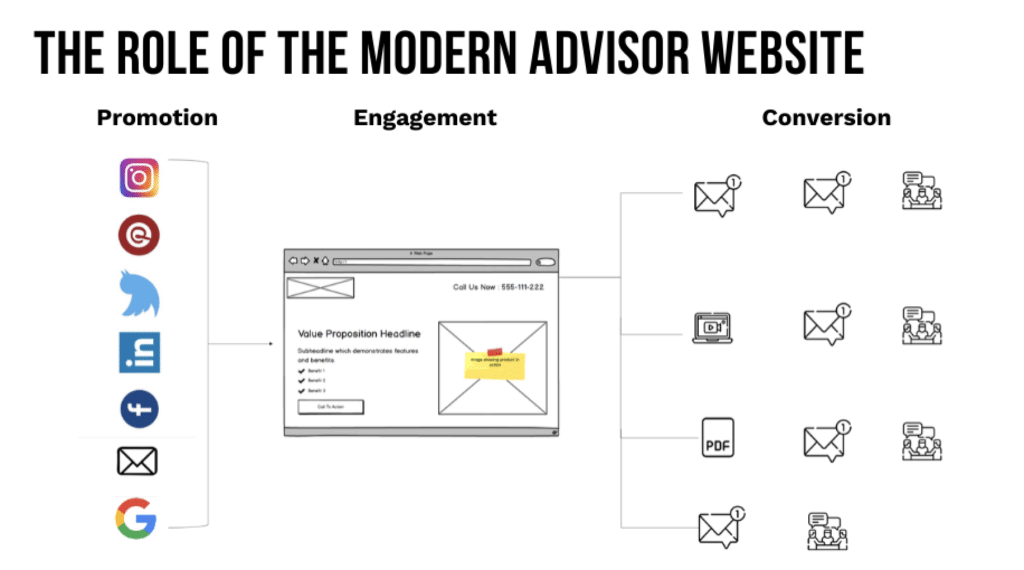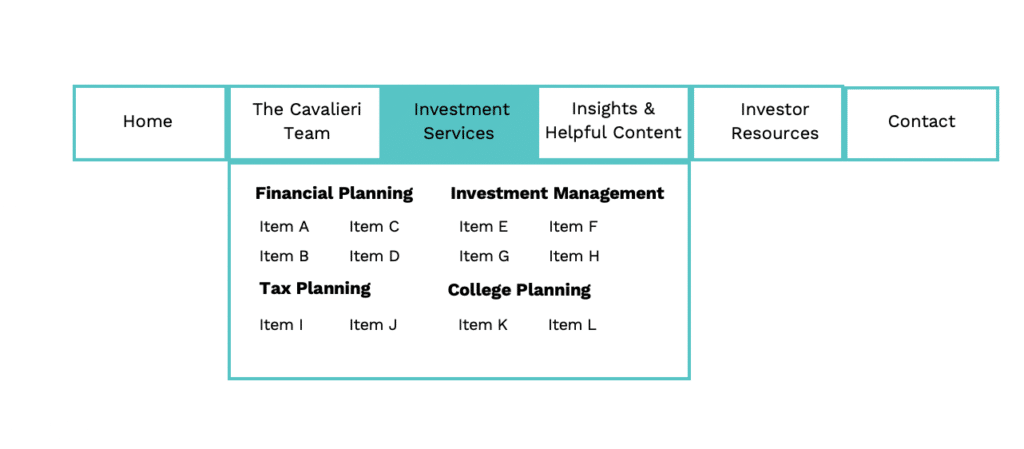Interested in learning more about the Advisor I/O platform?
Leave us your info and we'll send you more details
Blog Detail
Creating a Website That Converts
by Advisor I/O
We Dive Into the Tactics of Creating a Website That Converts in 4 Steps:
- Creating a cohesive, navigable structure and foundation
- Getting your messaging copy right
- Setting up lead magnets
- Optimizing other channels to push to your website
As the shift to digital-first communications continues to speed up due to COVID-19, your website is playing an increasingly important role for your practice. Gone are the days where your website is a place where you’d just have some content about your practice and team – an advisor’s website now needs to educate, entertain, and attract… Having a website that includes content and tools to help investors is table stakes.
How impactful (or not) can your website be? A few important stats to think about.
- You have 0-8 seconds to make a compelling headline and landing page.
- Approximately 96% of visitors that come to your website are not ready to buy.
- A prospective client forms a first impression of an advisor’s website in 50 milliseconds.
- A 1 second delay in your site speed can result in a 7% reduction in conversions.
- Small businesses with blogs get 126% more lead growth than small businesses without.
Your website can be your second sales arm – it can be used to convert unknown users into prospects and add value to clients once they are onboarded. But the modern advisor website is just one piece of the sales puzzle.
Michael Kitces put it best “Building a successful financial advisor website is all about building trust online.” The role of your website is to build enough trust for the investor to exchange contact information for some sort of value add – whether that’s a PDF download, invite to a webinar, free assessment, or other. The key is getting them to that next step of nurturing – explained below.

So, how can you create a website that converts? We cover 4 ways.
Create a Cohesive Structure and Foundation
Structuring your website means creating the right mapping that allows visitors to find information quickly and efficiently. Not only is it important to create a cohesive website structure for Google, but it’s important for your visitors. They need to understand exactly where to go and what information they need to find. There are three core elements that bring this cohesive structure to life – your primary navigation, subnavigation, and page structure. Let’s break down all three:
- Your primary navigation is the top few items that you have when someone lands on your website – i.e. home, about us, services, contact, etc. These items act as mini-houses and will store a number of pages throughout your website. A few things to keep in mind when creating your navigation.
- Don’t have more than 4-6 primary navigation items – think about a bucketing system for how you can bucket items together thematically – what pages you’ll need under “about” section? Does your blog cover different topics? Think about the highest-level order in how you want to group items.
- Order matters more than you think – think about the order in which you want people to discover information about your practice – your About Us usually comes in the beginning because most visitors are new. Your contact section comes at the end because people need to work through a decision process to reach out.
- Group items use your subnavigation – we’ll get into subnavigation below but think about how you need to group your content – not everything needs to have its own section or page.
- Be descriptive, avoid common terms – About Us is great but About The [your practice or team name] Team is better.
- Your subnavigation items are the items that live under each primary navigation – for example under Services, you could have financial planning and tax planning. The key is to think about group when it comes to your sub menu items.
- Use mega menus when possible – have groups within each subnavigtation list. Group sub-items into themes and topics. Don’t overkill on subnavigation – there are pages and content that may not need to be included in the navigation. Be descriptive, avoid common terms. An example of primary and subnavigation is below.

- In addition to how your website is structured, how your pages are structured is just as important. Each webpage on your website is an opportunity to engage and convert investors – each page structure needs to follow a specific flow.
- Think about page structure as a 3-part flow – where you explain what you’re going to talk about, where you share the details of what you’re talking about, and where you make an ask from the visitor.
- Supplement content with media – add videos, graphics, and charts to break up the flow of content throughout the page. Google loves this.
- Cross link related content – link to other related topics and articles.
- Always push the investor to a next step – a call-to-action
Get Your Messaging Copy Right
Copy can make or break a website – it’s the key differentiator. When you’re writing your website copy clearly define your audience, aim to use simple terms, lose the complexity, and test, test and test some more. What does this mean? Josh Patrick, an RIA in Vermont explained that “If we can’t explain what we’re trying to do in 500 words or less we either don’t understand it ourselves or haven’t thought thoroughly enough about the solution to provide an understandable explanation.”
We break it down further.
- Clearly define your audience before you create any web page copy
- Are you going after pre-retirees, young millennials, or business owners? Think about what they want and need prior to writing and be explicit about calling them out.
- Clearly state the value you provide that audience and how it’s different
- Define your differentiating factors, ensure they bleed through to your web copy.
- Your copy is not about you, it’s about your prospects
- A lot of advisors tend to play inside baseball – they use internal speak and language on their public website. Remember, it’s not about you, it’s about your prospects – think about the information they would want, back into your content from there. Reduce choices in your messaging – keep choices to 1 or 2 items for your customers.
Set Up Lead Magnets
Lead magnets are just what they sound like – assets that can allow users to exchange information for value. This could be a webinar, playbook, free assessment. Creating these points throughout your website will create options for users and also allow you to move them to the next step in the sales cycle. Some ideas to get you going:
- Playbook/Guide
- Whether you’re trying to educate people on retirement income or you’re explaining the tax planning process, short, to-the-point step by step guides can enable investors to navigate situations better. Build these guides to be helpful to the user – it’s not about what your practice can do or offer.
- Webinar
- With digital communications continuing to explode, webinars are a great tool to communicate concepts that can’t be explained in an article or video. Keep them under 25 minutes and actionable. No one wants to get on a webinar just to be sold to.
- Free assessment
- The tried and true method of free assessments still works when positioned the right way. The key is not for it to seem overbearing – meaning the investor shouldn’t provide too much information prior to the meeting being setup. Yes, you need information to perform the assessment, but you also need to balance the fact that this is their first interaction with you as an advisor.
Optimize Other Channels
The most important thing to remember is that if someone comes to your website, it likely won’t be the first or last interaction they have with you, which is why you need to ensure all of your channels are optimized. This includes your social media channels, your visibility on Google, and your follow up communications. Create consistent messaging across these channels and if someone comes to your website vs. social media, they have a similar brand interaction.
The Bottom Line
Your website can be a powerful tool for your practice, it can not only be used to educate people on what you do and who you are but can help them navigate their own specific situation. Focus on evolving your website, one tool, one feature, one message at a time. Remember that your website is never a set it and forget it – you’re playing the long game and your website needs to constantly evolve and adapt.




